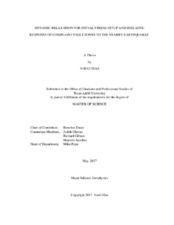| dc.contributor.advisor | Duan, Benchun | |
| dc.creator | Mao, Youli | |
| dc.date.accessioned | 2017-08-21T14:36:07Z | |
| dc.date.available | 2019-05-01T06:08:29Z | |
| dc.date.created | 2017-05 | |
| dc.date.issued | 2017-04-27 | |
| dc.date.submitted | May 2017 | |
| dc.identifier.uri | https://hdl.handle.net/1969.1/161381 | |
| dc.description.abstract | In this thesis, we first develop a dynamic relaxation technique to obtain the initial stress field that is in static equilibrium for elastoplastic dynamic rupture models using a dynamic solver. Then we examine inelastic response of fault zones to nearby earthquakes. Our dynamic relaxation method mainly relies on a dynamic loading scheme that is applied on the model boundary. The main advantage of such an explicit dynamic relaxation is that the global mass matrix is diagonal. In addition, the global stiffness matrix is not explicitly assembled. There are two main steps in our dynamic relaxation method for obtaining the stress field in the inhomogeneous model: first, choose appropriate boundary nodal force loading for the homogeneous model to obtain the desired stress field; second, apply the same boundary nodal force loading to obtain the stress field for the same size but inhomogeneous model. Through the two steps, we present a viable approach to calculate stress field for inhomogenesous models.
We apply the dynamic relaxation technique to study the inelastic response of the Calico and Rodman fault zones to the 1992 Landers earthquake. We develop elastoplastic dynamic rupture models to study the rupture propagation and final slip distribution on the Landers faults. The initial stress field in the elastoplastic model is obtained through the dynamic relaxation method. We present the simulation results of the inelastic response in terms of residual displacement fields on the Earth’s surface, and compare them with the InSAR observations in the East California Shear Zone. In addition, we compare our simulation results with those of elastic models from previous studies and show the advantage of elastoplastic models in term of data matching. The simulation results from our elastoplastic models show better match with the observed data compare to the results from previous elastic models. | en |
| dc.format.mimetype | application/pdf | |
| dc.language.iso | en | |
| dc.subject | Dynamic relaxation | en |
| dc.subject | Landers Earthquake | en |
| dc.title | Dynamic Relaxation for Initial Stress Setup and Inelastic Response of Compliant Fault Zones to the Nearby Earthquakes | en |
| dc.type | Thesis | en |
| thesis.degree.department | Geology and Geophysics | en |
| thesis.degree.discipline | Geophysics | en |
| thesis.degree.grantor | Texas A & M University | en |
| thesis.degree.name | Master of Science | en |
| thesis.degree.level | Masters | en |
| dc.contributor.committeeMember | Chester, Judith | |
| dc.contributor.committeeMember | Gibson, Richard | |
| dc.contributor.committeeMember | Sanchez, Marcelo | |
| dc.type.material | text | en |
| dc.date.updated | 2017-08-21T14:36:07Z | |
| local.embargo.terms | 2019-05-01 | |
| local.etdauthor.orcid | 0000-0002-6270-616X | |


